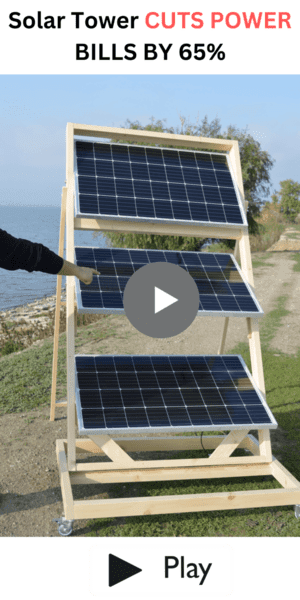Solar Energy Produced per Square Meter:
Solar panels are heading to the forefront of modern technology regarding renewable energy and cost-saving electricity generation. By transforming the sun's thermal energy into usable energy, solar panels can limit the use of fossil fuels and other environmentally hazardous energy sources around the world.
But how many will you need to buy to get your desired energy output?
"Solar panels produce about 150 watts of energy per square meter since most solar panels operate at 15% efficiency this translates to 15 watts per square foot."
Solar energy is widely available and is use for different purposes like warming and keeping cool houses, provide light to public spaces, and even power high-capacity commercial buildings when installed in relatively sunny locations.
To learn more about how solar panels work and how much energy they produce per square meter, continue reading below.
Solar Panel Power per Square meter:
Regardless of their exact material makeup, most solar power panels tend to operate at a total of 15% efficiency. With a lifespan of around 20 years, this means that they typically produce around
- 150 watts of energy per square meter, or
- 15 watts per square foot.
Convert calculator here
Total Energy Produced Per Sq Meter:
Since each residential home has around a minimum of 263.25 per sq foot or 24.45 square meters of solar panels installed, this equals at least 3.95 Kilowatts of total energy per sq foot or 3.67 Kilowatts of total energy per sq meter.
Calculations:
Residential One Solar Panels Size:
Typical residential solar panel dimensions:
17.55 sqft Feet to sq feet convertor
1.63 sq meter sq feet to sq meter convertor
Amount Of solar panels needed:
The required amount of most residential solar panels:
15 minimum
Calculate here how many solar panels are needed for your house
( 17.55*15 = 263.25 ) per sq foot
(1.63*15 = 24.45 ) per sq meter
Total Energy:
15watts per sq foot or 150 per sq meter:
15*263.25 = 3948.75 Watts Total energy per sq foot
150* 24.45 = 3667.5 Watts Total energy per sq meter
Watts per sq meter to kilowatts per sq meter calculator
3.95 kW Total Energy per sq foot or 3.67 KW Total Energy per sq meter
Efficiency calculate:
To calculate the true efficiency of your solar panel’s solar cells for more accurate energy estimations, you can use the following equation:
Efficiency = Pout / Pin. To calculate Pin (input power)
Factors That Affect Solar Energy Produced per Square Meter:
Solar Energy Affected:
Regardless of the type of solar panels you choose to use, it is crucial to understand that there are many outlying factors and uncontrollable weather patterns that can affect both the electricity amount and the performance of your solar panels. These include:
- Orientation of the tilt: If your solar panels are tilted facing directly north or south, they might not experience as much sun exposure as solar panels facing straight up or tiling to the east or west.
- Pollution: Cities and regions with extreme amounts of pollution, such as valleys that experience emissions inversions or metropolitan areas like Los Angeles, might not receive the same amount of energy from their solar panels as places with cleaner air.
- Regional location: It is best to install solar panels in a region that experiences warm weather throughout the year.
- Time: The amount of time you’ve had your solar panels will dictate how much energy reserve you can accumulate.
- Weather: On particularly cloudy, stormy, or rainy days, your solar panels will generate less power.
If you keep these factors in mind when installing your solar panels, you will be able to make informed choices and create realistic expectations for the amount of energy your solar panels will be able to produce.
Solar Energy Produced per Square Meter Effecting Electric Bills:
Electric Bills Affected :
If you have solar panels installed on your home that generate electricity, this electricity will most likely contribute to lowering your electric bill.
Calculation:
By using the number of kilowatt-hours produced by your solar panels and subtracting that number from any kilowatt-hours you may have used from the general power grid, you will receive a final billing number at the end of every billing cycle.
- If you have generated more electricity than you use, your power bill will reflect zero payments due..0
- If you have leftover power that you don’t use during a billing cycle, it will roll over to power your home for the next cycle until you no longer have a surplus of generated solar energy.
- If you are left with kilowatt-hour credits at the end of the year, ask your city about money-back programs in exchange for your solar power.
When filing taxes each year, those using solar power on their homes or businesses can receive a federal tax credit of up to 30 percent.
What’s in a Solar Panel, and How That Affects Efficiency of Energy Produced per Sq Meter:
Efficiency Affected:
Solar panels are created out of a material that converts regular light from the sun into usable electricity. This material is a semiconductor commonly known as silicon. In addition to silicon, some solar panels are also made of cadmium telluride, with new solar panel materials being invented and tested each year.
Silicon Wafer Technology:
The most common material for solar panels to be made of is silicone. This silicone comes in the form of monocrystalline and polycrystalline wafer panels. To make one of these silicon wafer panels, little slabs of silicon are placed in columns and tidy rows to make the shape of a rectangle. This rectangle is then fitted overhead with a glass sheet and secured with a frame-like device.
Most silicon wafer solar panels made from monocrystalline
look like small and flat black building blocks. Due to the way that the sun’s
light beams down on them, depending on the time of day and how it responds to
the pure silicon crystal material, they can often look somewhat black, gray, or
charcoal colored.
Cadmium Telluride:
When it comes to thinner solar panels called thin-films, cadmium telluride (CdTe) is the material of choice. Unlike monocrystalline or polycrystalline panels, these cadmium telluride panels are created by placing a thin transparent layer of CdTe in between conducting layers. This helps the conducting layers attract more sunlight molecules. On top of the conducting layers and cadmium telluride insets typically sits a pane of glass for protection from dirt and other weather elements.
Cadmium telluride has become a favorite material for homeowners in communities with Homeowner Associations or gated residences because the flat and thin technology allows for a more discreet solar panel aesthetic. Since the cells inside of each CdTe panel are slimmer than silicon solar panels by about 350 times, they are less easily seen from street level.
Learn DIY solar panels for home use and get methods for a cheap energy household use
Benefits of Different Solar Panel Types:
There are a few different kinds of solar panels with varying degrees of efficiency and aesthetic appeal. Some of the benefits and characteristics of these different solar panel types include:
- Monocrystalline silicon
○ High efficiency/performance
○ Higher costs for a longer lifespan
○ Low cost
- Polycrystalline silicon
○ Lower cost for lower efficiency and performance
○ Fast installation
- Thin-film or cadmium telluride
○ Portable and easy to move
○ Flexible and lightweight
○ Discreet appearance
○ Lack aesthetic to match dark rooftops
○ Lowest efficiency with low cost
While each of these three solar panel types has both pros and cons, they are all considered highly effective at harnessing the sun’s energy and turning it into reliable and usable energy for residential and commercial properties alike.
Final Conclusion: Money-Back Earth-Friendly Power
Solar panels are not only convenient for their ability to save money and remove dependency on the power grid, but they are also beneficial to the health of the environment. Whether you are considering solar panels for your home or your commercial business,
remember that at nearly 150 watts per square meter of clean energy, a 15% efficiency rate, and a total solar panel lifespan of around 20 years, solar panels can pay off in more ways than one.





.PNG)



